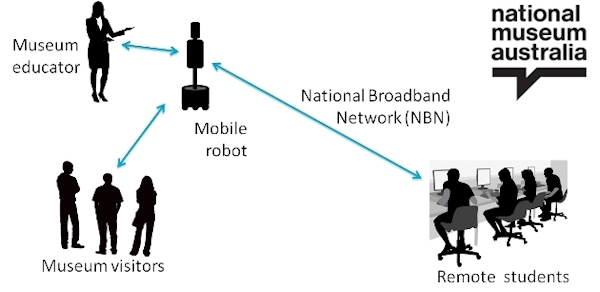[From CSIRO; follow the link at the end for more information, including an interactive preview]
Telepresence robot for museums
With support from the Department of Broadband, Communications and Digital Economy we’re creating a mobile tele-presence robot to help virtually connect school kids and visitors in regional areas with our Australian to the National Museum of Australia.
25 January 2013
The challenge
For many, a visit to a museum is an eye-opener, especially those institutions that offer hands-on interactive exhibits. But for even more people living in regional communities, museums are not hands-on; they are not even accessible, because of distance and cost.
Students in rural areas of Australia, the aged in nursing homes, or simply those people who stay at home, find it impossible to visit a museum, no matter how much they’d like to.
The solution
With funding from the Department of Broadband, Communications and the Digital Economy, we’re working with the National Museum of Australia to create and trial a mobile tele-presence robot. The museum robot will accompany education staff through the Landmarks gallery taking remote visitors on a virtual tour of the museum.
The robot, via a high speed broadband connection, allows the remote visitor to interact with a human educator in the museum. The human educator leads the robot whilst the remote visitors control the robot’s head, a 360 degree camera that allows them zoom up an explore items in the exhibit.
Apart from listening to the educator and looking around the museum, the remote students will also be able to see and interact with augmented reality information about each of the objects on display for example exploring images of objects in their original settings or during restoration.
A key feature of the system is the interactive nature of the experience. The museum educator will be able to engage and challenge the students by posing multiple-choice questions, polling and seeing the student’s responses via video link in real-time.
The impact
The mobile tele-presence technology developed by CSIRO in this project will offer a solution which will initially allow all schools with an NBN connection to visit our national museum and galleries.
The trial will demonstrate the educational outcomes and benefits of enabling remote museum visits via the Museum Robot enabled by the NBN. It will also provide an implementation blueprint for the ongoing operation of the technology in the National Museum of Australia and deployment in other institutions.
This technology will eventually allow all Australians with an NBN connection especially those in rural and regional areas to experience and access a range of our national treasures whether in a museum, under the sea at the Great Barrier Reef or at a remote cave in the desert despite the tyranny of distance.
Senator the Hon Stephen Conroy, Minister for Broadband, Communications and the Digital Economy has praised the project. “The Museum Robot is another example of CSIRO undertaking cutting edge work. It’s an exciting project that will allow everyone to enjoy an interactive tour of a museum from wherever they live. I am sure it will open up new opportunities in education, particularly for children living in regional and remote Australia.”
Find out more about the Museum Robot project or contact our business development team if you are a museum, institution or business interested in a tailored mobile tele-presence solution.
—
Contact Information
Dr Jonathan Roberts
Research Director, Autonomous Systems Laboratory
Phone: +61 7 3327 4501
Alt Phone: +61 7 3327 4444
Email: Jonathan.Roberts@csiro.au
Prof Y Jay Guo
Reseach Leader, Smart Secure Infrastructure
Digital Productivity and Services Flagship
Phone: +61 2 9372 4291
Email: Jay.Guo@csiro.au
Mr Jonathan Lacey
Business Development Manager, Smart Secure Infrastructure
Digital Productivity and Services Flagship
Phone: +61 3 9662 7147
Email: Jonathan.Lacey@csiro.au
